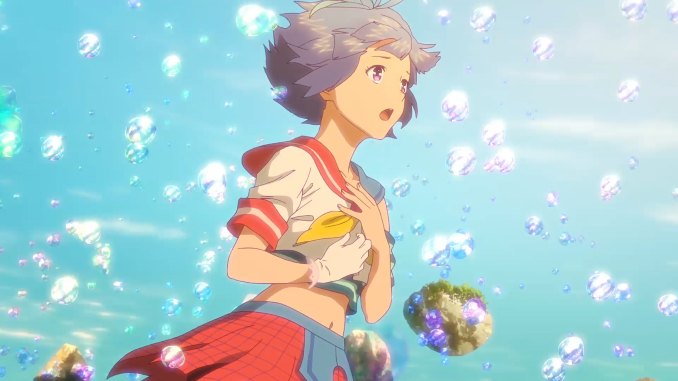
One of the preeminent anime studios in the world, Wit Studio, has released acclaimed titles such as Attack on Titan, Vinland Saga and Ranking of Kings. Their newest original title in collaboration with Netflix, Bubble, features direction from Attack on Titan helmer Tetsuro Araki and a screenplay by Puella Magi Madoka Magica scribe Gen Urobuchi. With this pedigree, the expectations for the science fiction story are pretty high. What we get is a hybrid parkour battle anime with elements of Hans Christian Andersen’s The Little Mermaid sprinkled in.
Bubble takes place in Tokyo, five years after a catastrophic event known as The Bubble Fall, which changed life in the city forever. Millions of bubbles filled the air and caused mass disruption to the lives of the Japanese. After an enormous blast at Tokyo Tower, the bubbles stopped for the most part, except for in the capital city. When the bubbles began to burst, they flooded large areas of the city, making it uninhabitable. Yet, this Tokyo became prime real estate for the many children orphaned by the Bubble Fall. These children now make the sunken city their home and partake in parkour battles for supplies and bragging rights.
One particular orphan with all-star abilities, Hibiki (Jun Shison), has a sensitivity to sound that allows him to hear a strange song emanating from the bubbles. While attempting to find the source at Tokyo Tower, a misstep leaves him on the precipice of death, drowning in the floodwaters. It’s here that he meets a mysterious girl, Uta (Riria), who saves his life and might hold the key to solving this catastrophe.
The animation in Bubble pops off the screen. All the characters flow effortlessly throughout the waterlogged city, and having parkour be the central means of navigation allows the characters to use this phenomenon to their advantage. Tokyo being devoid of additional life enables the creators to make a giant playground out of the city. In what I’m calling “parkour vision,” the camera rotates around the characters, sometimes transitioning into a first-person perspective while they navigate the terrain. It adds a lot of depth to what we see, and it’s thrilling watching the characters jump off of buildings and use bubbles as stepping stones. Death Note artist Takeshi Obata provided the character designs and there are instances where the camera will freeze on the protagonists to show off their incredible looks.
That said, originality isn’t a strong suit for Bubble. A number of characters are built off of stock archetypes, none as painful as the female protagonist. Uta, as a magical girlfriend, has been compiled using an encyclopedia’s worth of anime tropes. Even though Uta lacks the ability to speak (yikes), she becomes an instant expert in parkour and other elements of human life. Not to mention she’s absolutely obsessed with Hibiki. Hibiki’s sensitivity to sound has always made him feel like an outlier, but Uta brings out the best in him and opens up his heart to things he never experienced before. The script tries to disguise a lot of these obvious tropes, using the framework of The Little Mermaid fable, but despite drilling that comparison home it comes across as uninspired.
You can pinpoint exactly where Bubble loses its momentum, because the film literally pauses to explain itself. Bubble’s problems begin with its multiple monologues where the action stops so that the concepts can be explained—parkour battles, Bubble Fall, Tokyo Tower, etc. Urobochi and company have envisioned this world and its characters as something of a puzzle that needs to be unlocked, but none of that happens organically through the story. Urobochi’s known in anime for his dark, unforgiving series—the action takes place in dystopian worlds and some form of tragedy is likely to befall the protagonists. Some of it works, but mostly it adds too much doom and gloom to something that begins as an entertaining sports anime, and transitions into something else entirely.
Bubble is undoubtedly a stunning film featuring some of the brightest stars of Japanese animation. That animation is key, as the showstopping moments from Hibiki and company magnificently jumping through the environment is one of the biggest reasons to delve into this world. These moments can often be thrilling. Unfortunately, despite all this talent, Bubble never amounts to something wholly unique—falling into predictable tropes and a narrative that ends up being a little too self-serious for a parkour adventure with bubbles.
Director: Tetsuro Araki
Writers: Gen Urobuchi
Starring: Jun Shison, Riria, Marina Inoue, Mamoru Miyano
Release Date: April 28, 2022 (Netflix)
Max Covill is a freelance writer for Paste Magazine. For more anime, movie, and television news and reviews you can follow him, @mhcovill.














